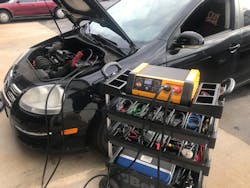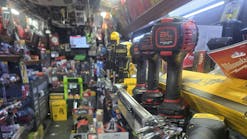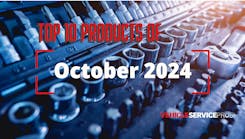In today’s shops, technicians encounter several different types of batteries every day. The battery, no matter the type, is one of the most important components on a vehicle as it provides the power needed to keep the engine running. As essential as the battery is to the vehicle, it is just as essential for technicians to have the right tools and equipment when servicing batteries and the entire electrical system.
From sealed lead acid (SLA) batteries, absorbed glass mat (AGM) batteries, and enhanced flooded batteries (EFB), to the up-and-coming Li-ion batteries, battery technology continues to evolve as vehicle technology progresses. The demand for more electronics coming standard in vehicles is on the rise, as well.
Each of the battery types listed above needs to be charged differently. And since many batteries are no longer found under the hood, but in places like under the driver’s seat, under the rear seats, or in the trunk, testing can become an issue. While this opens up a host of issues for technicians, it also offers tool dealers an opportunity to help their customers find the right equipment to make their jobs easier.
“Shops generally want more options [such as] chargers safe for use with multiple battery types, jump start help, and adjustable voltage options,” says Joel Simmons, an independent tool distributor based in Louisville, Kentucky.
Simmons notes that he sells a decent number of battery servicing tools and equipment across the board; however, he notes charging equipment is at the top of the list.
Brief battery history
Ten to 15 years ago, the industry saw a shift in battery technology from sealed lead acid (SLA) and flooded acid batteries to absorbed glass mat (AGM) batteries. AGM batteries are still the most popular battery type installed in vehicles today. AGM batteries are sealed, maintenance-free, and can withstand extensive shock and vibration.
With the evolution of start-stop engine systems where the engine shuts down when the vehicle comes to a complete stop and then starts back up when the driver’s foot lets off the brake, AGM batteries became more prevalent. The adoption of start-stop technology was used as a way to meet Corporate Average Fuel Economy (CAFE) standards put into place by the government for better fuel efficiency.
EFBs came next. These are a hybrid between SLA and AGM. EFBs support start-stop technology and are similar to standard flooded batteries, but have enhanced cycling abilities and improved charge acceptance.
Li-ion batteries, the latest technology, began showing up about five years ago in European vehicle makes such as Mercedes-Benz and Porsche. These batteries are very energy dense, delivering power in a compact, lightweight package.
Changes in charging requirements
In the past, if a battery needed charging, technicians would grab a battery charger with a simple timer to regulate the length of time the charger would charge the battery. Today, each battery types needs to be charged differently.
“You must have a charger that is marked for each of these battery types or it is not recommended to use,” says Gary Mackey, vice president of global sales and marketing at Associated Equipment.
In addition, many battery manufacturers are requiring their batteries be charged at different voltages.
SLA batteries charge at around 15.5V; AGM batteries at 14.4V (this was previously 14.8V) since they don’t have free flowing electrolyte or battery acid; EFBs at 14.7V; and Li-ion batteries are the most sensitive and charge at 13.6-13.9V, Mackey notes. He advises technicians should have an adjustable voltage charger nearby to accommodate these updated charging specifications.
Failure to charge batteries properly can result in significantly shortening their life, sulfation, or cause immediate failure. Batteries are very sensitive to excess voltage and require specific, controlled charging.
Additional servicing capabilities
Depending on the customer’s needs in regard to the battery and electrical system service they provide, some additional capabilities may prove useful, or even critical, when completing a repair. For one, the need for stable power is much greater now than it was in years past.
“Every single bay needs to have a charger with a power supply capability,” says Jim O’Hara, vice president of marketing at Clore Automotive. “There are many different reasons why [a technician] needs to be providing stable power to the vehicle. The way the vehicle is configured, in order to diagnose it, repair it, and service it is changing, [which] changes the way the charger is needed or deployed in the bay.”
O’Hara provides a few examples:
“When doing diagnostics on the electrical system, specifically if I’m trying to find an intermittent fault, one of the things that I’m going to want to do is take the battery out of the equation,” he says. “The easiest way to do that is to put a power supply on it and hold the battery’s voltage at a set level. Now I can command a relay or other components inside that system and diagnose their function without worrying that I’m draining the battery.”
Also, when servicing an electronic subsystem such as an electronic brake system, a technician will be firing a module throughout the repair, which needs power. Connecting a power supply to the vehicle maintains a steady voltage, eliminating any interference with the repair, O’Hara notes.
The need for stable power is also required when performing a reflash, the process of updating the vehicle’s software. The vehicle must be connected to a battery charger or power supply made specifically for this event. The process may take up to 12 hours, and it’s important that the battery voltage doesn’t drop below a certain threshold, otherwise the process will stop and possibly damage the module.
Clore Automotive’s 12V 100A Flashing Power Supply and 60/40/10A Battery Charger, No. PL6100, is designed to provide stable power to a vehicle electrical system. The unit is ideal for diagnostic efforts related to the electrical system, repairing of an electronic subsystem, support for module reprogramming, as well as ADAS recalibration.
Having a means of retaining the memory in the vehicle during a battery replacement or electrical service is also greater now than in the past. With more electrical components coming standard on vehicles, disconnecting the battery cables without providing backup power to the electrical system can be very costly. It may even require a complete computer reflash.
Loss of presets including clock, radio stations, seat positions, preprogrammed navigation settings, and even alignment, electric windows, sunroofs, and steering angle are just some systems that may be affected if a memory saver was not used.
Associated Equipment offers an Intellamatic Smart Battery Charger and Analyzer, No. IBC6008MSK, that is designed to charge all battery types, including Li-ion, and has an adjustable reflash power mode. It also features a 12V power port for use with a memory saver and comes with a 12’ OBD-II memory saver cable.
In vehicles that have smart charging systems, if a battery is fully charged the alternator does not put out any amperage to charge the battery in order to reduce load on the engine to improve fuel economy – the system needs to be reset when the battery gets replaced, Mackey says.
As the vehicle’s battery ages and degrades, the smart charging system adjusts its output in order to compensate and keep the battery at an optimal state of charge.
“There are about 1,800 vehicle models on the road today that must be reset when the battery is replaced,” Mackey says.
If a reset is not performed, the new battery’s life may be shortened, the vehicle won’t start, or additional electrical issues may arise.
Some scan tools currently have the functionality to complete this reset/registration procedure for some vehicle models. Associated Equipment will be introducing a universal tool (Battery Registration Tool, No. AEC200) capable of performing this procedure for most makes and models.
And then there’s testing
From a charging standpoint, a start-stop AGM battery will charge the same as a standard AGM and an EFB will charge the same as a flooded battery. However, from a testing standpoint they are not the same.
“When we go to test them, specifically with an electronic tester, they’re not the same because when we send that pulse through the battery to diagnose the battery’s condition, the way that pulse reacts with the battery and the signal that’s sent back can be different,” says Clore Automotive’s O’Hara. “So, we need to have different testing methods.”
O’Hara suggests having an electronic tester that can test the different judgement map, or internal construction, of each battery. Each battery type is constructed differently, and therefore will react to the electronic pulse differently.
The BA327 from Clore Automotive is a digital battery and system tester capable of testing six battery types: flooded, AGM flat plate, spiral wound, gel cell, start-stop AGM, and EFB. It has a 1.5-30V operating range and 40-2,000 CCA testing capacity.
“It is always best to have an accurate, dedicated battery tester in the shop, but you can still perform many of the tests with just a voltmeter or circuit testers,” says Gerald Tabas, sales and marketing manager at Power Probe Tek.
Power Probe Tek’s line of circuit testers (PP3, PP3EZ, PP4, and Maestro) are all capable of measuring voltage and are normally already connected directly to the vehicle’s battery terminals, so measuring battery voltage can be as simple as pressing the rocker switch and reading the battery voltage on the display, Tabas says. The open circuit voltage will indicate the percentage of charge in the battery.
The new 3EZ and Maestro from Power Probe Tek include built-in guided diagnostic functions that take the technician step-by-step through battery and charging system tests and provide an instant pass/fail result.
O’Hara and Tabas agree direct battery connection is best. However, as vehicle designs and technology evolve, some batteries are no longer commonly found under the hood. Instead, they are remotely mounted under the driver’s seat, under the rear seats, or in the trunk, providing a new challenge for the technician.
Tabas notes that Power Probe Tek offers an option of connecting through the cigarette lighter port with an available adapter included in many of their kits.
Associated Equipment’s Mackey suggests the best way to test batteries found in various locations of the vehicle is with a variable load tester.
“Several OEM vehicle manufacturers have approved load testers in their program to test the battery from the charging posts before going through the work of pulling the seats or trunk liners from the vehicle,” he says.
If the battery tests weak or defective, it can be pulled and tested with a tester that is approved from warranty claim documentation, Mackey adds.
Selling tips
When it comes to selling battery and electrical system tools and equipment, independent tool dealer Simmons says staying up-to-date on technology is key.
“The options for chargers and testers, [which range] from $25 to $2,000, seem endless,” he says. “In an age where batteries can be using algorithms and battery resets in vehicles, staying current on technology and knowing exactly what the customer will be servicing is a must. This helps you be more than just a salesman, it’s what makes you a tool dealer.”
Simmons’ biggest concern when selling is making sure the customer gets at minimum what they need, if not usually more. He says it’s better to have a customer come back excited because a tool exceeds their expectation than to have them frustrated or disappointed.
“When it comes to battery chargers, I always ask what it is exactly that they want to do,” Simmons shares. “I have found out that most of the time guys are misinformed about battery chargers and assume they are all basically the same. Even when I ask what exactly they need out of a charger, it usually takes multiple questions to figure out what they are actually looking for in a charger.”
When you take the time to understand what the customer needs, that gives them confidence in you, and educating them can lead to a larger sale, Simmons concludes.



